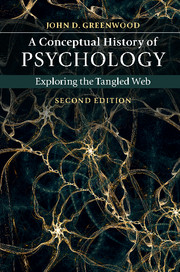Book contents
- Frontmatter
- Contents
- Preface
- 1 History, science, and psychology
- 2 Ancient Greek science and psychology
- 3 Rome and the medieval period
- 4 The scientific revolution
- 5 The Newtonian psychologists
- 6 Physiology and psychology
- 7 Theories of evolution
- 8 Psychology in Germany
- 9 Psychology in America: the early years
- 10 Functionalism, behaviorism, and mental testing
- 11 Neobehaviorism, radical behaviorism, and problems of behaviorism
- 12 The cognitive revolution
- 13 Abnormal and clinical psychology
- Epilogue: the past and future of scientific psychology
- Index
- References
3 - Rome and the medieval period
Published online by Cambridge University Press: 05 September 2015
- Frontmatter
- Contents
- Preface
- 1 History, science, and psychology
- 2 Ancient Greek science and psychology
- 3 Rome and the medieval period
- 4 The scientific revolution
- 5 The Newtonian psychologists
- 6 Physiology and psychology
- 7 Theories of evolution
- 8 Psychology in Germany
- 9 Psychology in America: the early years
- 10 Functionalism, behaviorism, and mental testing
- 11 Neobehaviorism, radical behaviorism, and problems of behaviorism
- 12 The cognitive revolution
- 13 Abnormal and clinical psychology
- Epilogue: the past and future of scientific psychology
- Index
- References
Summary
With the defeat of Athens by Sparta in the Peloponnesian war (431–404 BCE), the Greek city–states began to disintegrate. By the time Aristotle died in 322 BCE, they had become part of the short-lived Macedonian Empire, founded by Alexander the Great. Republican Rome invaded shortly afterward, and they were eventually incorporated into the Roman Empire. The center of learning shifted from Athens to Alexandria in Egypt.
The Romans were great technologists and administrators, but contributed little to the development of science. Mystical forms of Neoplatonism became popular and informed the emergence of Christianity in the early days of the Roman Empire. When Christianity was accepted as the state religion, the works of pagan scholars such as Pythagoras and Aristotle were denigrated and condemned. With the decline of the Roman Empire, western Europe entered what is known as the Dark Ages, a time when many of the classical Greek texts were destroyed or lost. Alexandrian scholars fled to Constantinople, then to Persia, where the classical texts were rediscovered by Islamic scholars and eventually by Christian scholars with the advent of the Crusades. During the middle and later medieval period, Aristotle's natural philosophy was integrated with Christian theology, effectively fossilizing his theories as church dogma.
Although science developed little during the medieval period, the medievals were not as hostile to it as is commonly supposed. They did not generally persecute practicing scientists and did not burn hundreds of thousands of neurotic and psychotic women whom they misdiagnosed as witches. What was distinctive about the medieval period was the general lack of interest in the empirical evaluation of scientific theories, including psychological theories. Most medieval scholars were content to develop their theories based upon classical and theological authorities.
The Roman age
The Roman age began with the 500 years of the Roman Republic prior to the time of Julius Caesar (100–44 BCE), during which the Senate governed Rome. After Caesar's assassination, Rome was governed by a series of emperors, beginning with Augustus (63 BCE–14 CE). The Roman Empire, which stretched from the British Isles to the Middle East at the height of its power, brought stability and order to the Mediterranean world for nearly 400 years, until it collapsed as a result of internal pressures and external invasions.
- Type
- Chapter
- Information
- A Conceptual History of PsychologyExploring the Tangled Web, pp. 41 - 63Publisher: Cambridge University PressPrint publication year: 2015



